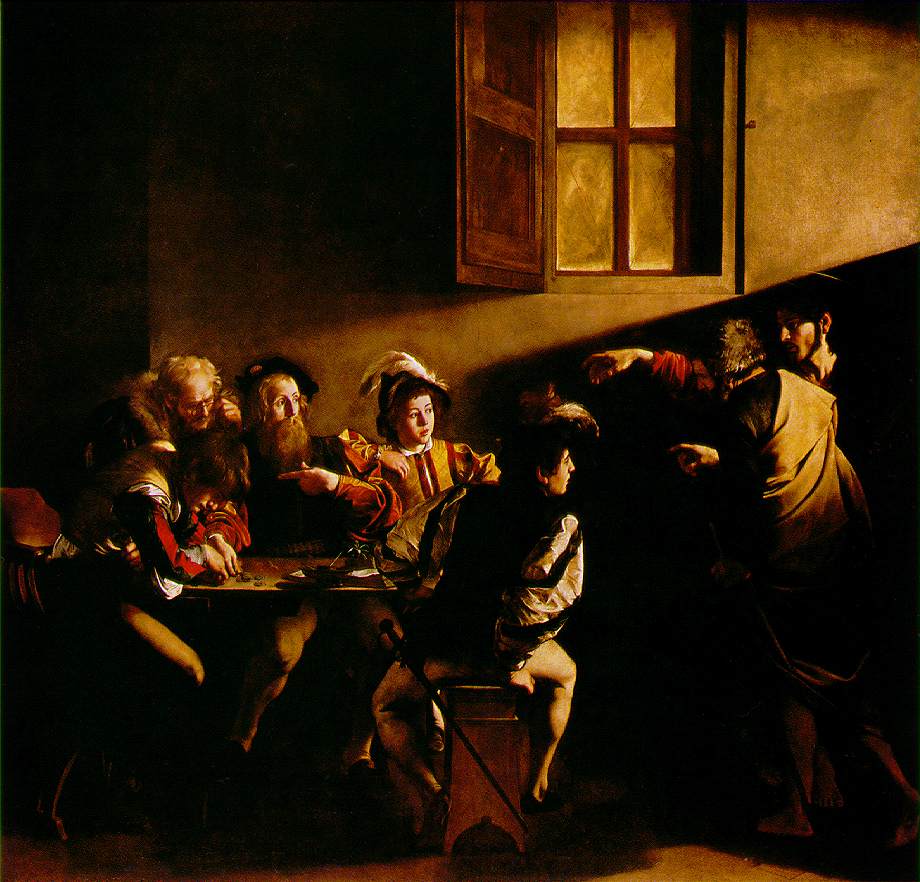Unit 3 - Quest for Fire

Caravaggio, The Calling of St. Matthew, c. 1599-1602,
oil on canvas, 11'1" x 11'5" (3.4 x 3.5 m),
Contarelli Chapel, SS. Luigi dei Francesi, Rome.
Here we have a nice painting of a group of convivial men dressed in tights having a bit of a chat at a tavern. While there is no wine or beer at the table one can be sure that at some point drinks were had by most of those present, because, as you may have already surmised, the bearded fellow on the left is Matthew, the tax man (one of his "agents" sits counting out coinage at the end of the table), come to collect his due. And what better thing to do with a tax man than ply him with drink and food--I have plans to do this myself sometime in the not so distant future.
This painting, by the Italian artist Caravaggio (an important predecessor of Rembrandt-the Dutch artist who made many self-portraits--one of which was quite famously stolen and to this day hangs in an unknown locale to the secret delight of some unknown person) has been deemed by the art historical establishment to be one of the most important in the artistic canon. While I could go on at length about the story of Matthew, the artist's use of surprisingly ordinary figures to portray a religious scene, and the positioning of those figures, or even about Caravaggio's direct quote of Michelangelo's Creation of Adam in the form of the hand of Jesus pointing towards Matthew, I don't want to focus on any of these things. What I want to focus on here is the use of light, the thing which Caravaggio is perhaps best known for and which is one of the most direct links between himself and Rembrandt, and which, I would like to add, was a point brought up in last week's class discussion by a very astute student who should feel complemented that I am now stealing his point and making it something of my own.
Light was known to us first as a blinding glow from the skies in the form of the sun and then captured by we humans in the form of fire--the thing that allowed that schmuck in the cave at Lascaux to work long into the night despite having bones and rocks thrown at him from the ones trying to sleep. For artists, particularly those of Caravaggio's era (whose use of light is known as chiaroscuro, meaning, literally, light-dark in Italian--a term very familiar to those film buffs among you who favor noirish-type cinema), light represented many things, but most specifically god, or, as you may interpret it, knowledge and power. When you compare this warm Italian sun pouring into the earthy tavern setting (forgetting momentarily about the finger so rudely pointed at the bearded guy) with the harsh flourescence in last week's work by Gursky, one begins to wonder about light, not only in art, but in our lives. One begins to look at our myriad uses for and ideas about light, particularly in social settings--the lighting in which we prefer to spend time with our intimates, the lighting in which we prefer to interrogate criminal suspects, the ever-changing light that bathes our endlessly spinning little planet...
Related
Links:
A site that discusses Caravaggio's work in the Caparelli Chapel.
A different
site that discusses the same thing, but this time in Italian.
A description
and review of the inimitable film, Quest for Fire - whch you must
see if you have not already, and which you should see again if you have
(though I do feel compelled to warn you that there is some adult content).
An exhaustive discussion
of many fire-making methods.
The official website for the Burning
Man festival which takes place every year out in the Black Rock Desert.